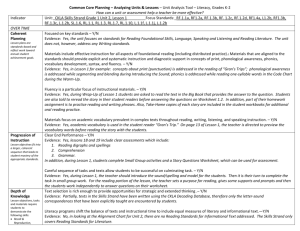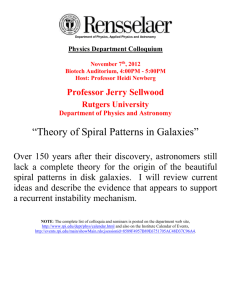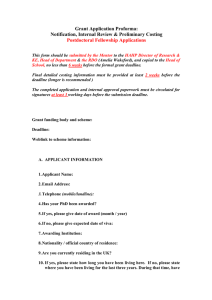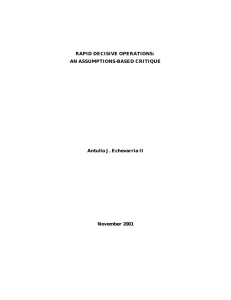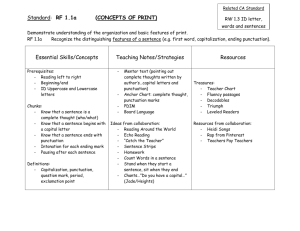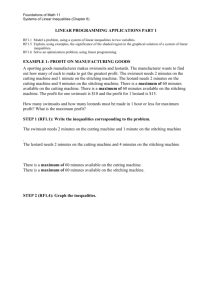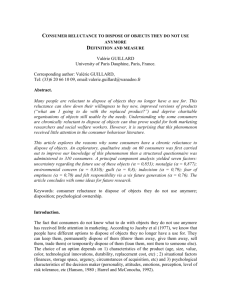RAPID DECISIVE OPERATIONS: AN ASSUMPTIONS-BASED CRITIQUE Antulio J. Echevarria II November 2001
advertisement
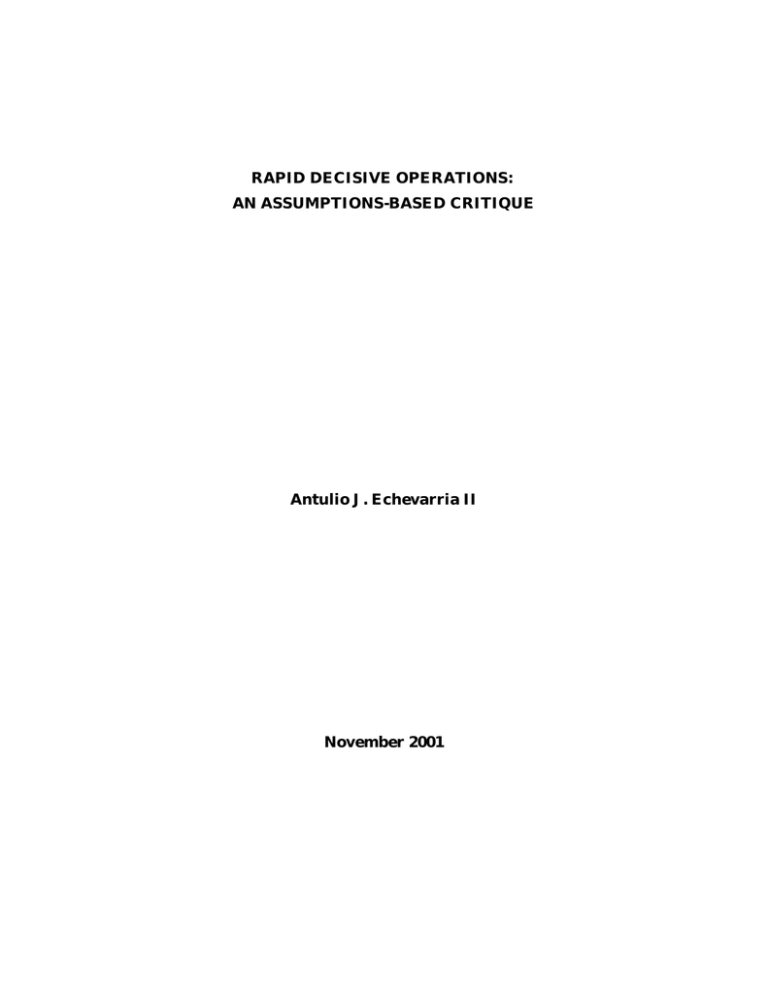
RAPID DECISIVE OPERATIONS: AN ASSUMPTIONS-BASED CRITIQUE Antulio J. Echevarria II November 2001 ***** The views expressed in this report are those of the author and do not necessarily reflect the official policy or position of the Department of the Army, the Department of Defense, or the U.S. Government. This report is cleared for public release; distribution is unlimited. ***** Comments pertaining to this report are invited and should be forwarded to: Director, Strategic Studies Institute, U.S. Army War College, 122 Forbes Ave., Carlisle, PA 17013-5244. Copies of this report may be obtained from the Publications Office by calling commercial (717) 245-4133, FAX (717) 245-3820, or via the Internet at Rita.Rummel@carlisle.army.mil. ***** Most 1993, 1994, and all later Strategic Studies Institute (SSI) monographs are available on the SSI Homepage for electronic dissemination. SSI’s Homepage address is: http://carlisle-www.army. mil/usassi/welcome.htm. ***** The Strategic Studies Institute publishes a monthly e-mail newsletter to update the national security community on the research of our analysts, recent and forthcoming publications, and upcoming conferences sponsored by the Institute. Each newsletter also provides a strategic commentary by one of our research analysts. If you are interested in receiving this newsletter, please let us know by e-mail at outreach@carlisle.army.mil or by calling (717) 245-3133. ISBN 1-58487-073-7 ii FOREWORD Most experts agree that no genuine military transformation or revolution will occur without a corresponding change in operational concepts. Merely replacing old equipment with new is not enough. Militaries must also develop new ways to link tactical actions to strategic ends. For this reason Rapid Decisive Operations (RDO), an emerging concept currently under development by the Joint Futures Lab (J9) of Joint Forces Command, is particularly important for the transformation of U.S. military forces today. An innovative and viable concept will not only stimulate the development of new technologies; it will also help balance the advantages and disadvantages that the introduction of such technologies always entails. On the other hand, a flawed concept will only lead to frustration in training and disappointment in combat as results fail to match expectations. In support of the Joint community’s efforts to develop a viable operational concept, Lieutenant Colonel Antulio J. Echevarria II has written an assumptions-based critique of RDO. He argues that the concept’s developers deserve high praise for attempting to link two relative properties—speed and decisiveness—but that the definition of RDO is at present incoherent and based on several deeply flawed assumptions. He concludes that RDO creates dubious expectations and will likely fail to balance the strengths and weaknesses introduced by new technologies. Lieutenant Colonel Echevarria further recommends a method for identifying and addressing an operational concept’s critical assumptions. This method, which offers a way to adjust operational concepts before they have claimed too much in the way of resources, ought to become a standard part of concept development. DOUGLAS C. LOVELACE, JR. Director Strategic Studies Institute iii BIOGRAPHICAL SKETCH OF THE AUTHOR ANTULIO J. ECHEVARRIA II, a lieutenant colonel in the U.S. Army, is currently assigned as the Director of Strategic Research at the Strategic Studies Institute. He graduated from the U.S. Military Academy in 1981, was commissioned as an armor officer, and has held a variety of command and staff assignments in Germany and Continental United States; he has also served as an assistant professor of European history at the U.S. Military Academy; Squadron S3 of 3/16 Cavalry; Chief of BN/TF and Bde Doctrine at the U.S. Army Armor Center at Fort Knox; as an action officer at the Army After Next project at HQ TRADOC, Ft. Monroe, VA; and as a speechwriter for the U.S. Army Chief of Staff. He is a graduate of the U.S. Army’s Command and General Staff College, and holds M.A. and Ph.D. degrees in History from Princeton University. He has published articles in a number of scholarly and professional journals to include the Journal of Military History, War in History, War & Society, Parameters, Joint Force Quarterly, Military Review, and Airpower Journal. His book, After Clausewitz: German Military Thinkers before the Great War, was published by the University Press of Kansas in the spring of 2001. iv SUMMARY Technological innovation plays a paradoxical role in military transformation. With each problem it solves, technological innovation tends to introduce new challenges or complications. Operational concepts can partly reconcile these tensions by finding the optimal balance between technological strengths and weaknesses. In so doing, they perform two vital functions (integrating and stimulating) for military transformation. The concept of Rapid Decisive Operations (RDO) also attempts to perform each of these functions. However, its definitional incoherence and faulty assumptions have caused the concept’s stimulating function to exceed its integrating one. This monograph examines the coherence of the definition of RDO, identifies and analyzes several of its critical assumptions, recommends a method for identifying other assumptions, and then proposes a reasonable alternative to RDO. The Concept Defined. RDO is incoherent, containing no rationale for rapid operations and only an impartial definition of decisive ones. While the White Paper identifies the requirements necessary to make RDO rapid and decisive, it is not clear whether RDO can occur if some of the requirements are absent. It is also difficult to understand why the United States should invest more defense dollars to develop RDO when it has very limited application across the spectrum of operations (i.e., the concept is most applicable in high-end, smaller scale contingencies such as Grenada, Haiti, Panama, and Desert Shield) and since it merely perfects an approach to war in which the United States is already superior. v Critical Assumptions. While definitional contradictions and inconsistencies can be easily corrected, the same is not true of critical assumptions. RDO’s first and most egregious assumption is that the National Command Authorities (NCA) will desire military forces that are rapid and decisive in all scenarios. Political leaders might well prefer a gradual approach in most cases. The second faulty assumption is that U.S. forces will possess perfect or near-perfect knowledge of the enemy. Information technologies have not yet lived up to expectations in this regard. The third flawed assumption underpinning RDO is that an adversary is a system of systems that can be paralyzed by a few well-placed strikes against his critical nodes. Although a worthy goal, history shows that such paralysis rarely occurs. A fourth faulty assumption is that one can identify, attack, and destroy whatever an adversary values most, and in so doing break his will to fight. Ideology and political realities make this a facile solution for some situations and completely unrealistic for others. The fifth faulty assumption underlying RDO is that all elements of national power can be brought together in a single operation that is both rapid and decisive. For example, some of the most potent tools of economic power—blockades and sanctions—generally require a great deal of time to work and often entail a significant amount of collateral damage. Identifying and Analyzing Assumptions. Concept development would benefit from a process that required the identification and analysis of critical assumptions. With minor effort one could modify the Assumption-Based Planning tool developed by the RAND vi Corporation for such uses. Assumption-Based Planning involves five steps: 1) identifying the explicit and implicit assumptions expected to remain true over a reasonable time horizon; 2) identifying assumption vulnerabilities; 3) defining signposts that will indicate when one or more assumptions has become vulnerable; 4) defining appropriate shaping actions that avoid assumption vulnerabilities; and 5) defining hedging actions that minimize the impact of an assumption failure. However, even Assumption-Based Planning is not a silver bullet. An Alternative Concept. Whereas RDO focuses on attacking an opponent’s center of gravity or threatening “what he values most,” a concept that concentrates on interdependent—or fully Joint—maneuver would permit policymakers to determine for themselves what the military instrument should accomplish. The Joint Staff’s experimenters should analyze the kinds of political objectives that U.S. military forces will most likely have to accomplish over the next 15-20 years, and then develop ways to get at them. Attacking what the enemy values most is not always the best route to the objective. In sum, RDO fails in its integrative function. It is an incoherent concept that rests on several faulty assumptions. To prevent such concepts from creating false expectations and leading to potentially disastrous results, the U.S. military will need a process for identifying and analyzing assumptions in concept development. vii RAPID DECISIVE OPERATIONS: AN ASSUMPTIONS-BASED CRITIQUE Antulio J. Echevarria II Whether one believes that the current transformation of the U.S. military is part of a comprehensive Revolution in Military Affairs (RMA) or merely a reasonable response to evolving operational and strategic demands, change is clearly underway. Yet, technological innovation—a major driver of such change—plays a paradoxical role in military transformation. Today, a growing number of weapons can strike with greater accuracy over extended distances; however, those same or similar weapons in the hands of an adversary will mean significant anti-access challenges for friendly forces. Innovations in fuel and propulsion systems may help to reduce the cumbersome logistical tail of maneuver forces, but the longer distances that such forces must traverse will, in turn, put additional strains on those systems. Information and communication systems can enhance operational control and facilitate decentralized operations, yet they also require larger staffs and more skilled junior leaders trained to operate independently. In a final example, advances in biogenetic engineering have already revealed several ways to increase (as well as exploit) the physical capacities of individual soldiers; however, they have also raised complex moral and ethical questions about doing so. In short, with each problem they solve, technological innovations tend to introduce new challenges or complications. Fortunately, operational concepts can partly reconcile such tensions. They can find the optimal balance between technological strengths and weaknesses. If technological innovations do not permit the reduction of logistical tails, for example, operational concepts could aim at achieving 1 the best possible results within existing logistical constraints. Concepts also provide a mark on the wall for technological development, stimulating the research and development communities to move beyond current capabilities toward those described in vision documents such as Joint Vision 2020 (JV2020). In short, operational concepts occupy the intellectual space between doctrine and vision and help convert desired capabilities (vision) into something practicable (doctrine). Hence, operational concepts perform two vital functions (integrating and stimulating) in the course of a military’s transformation. The concept of Rapid Decisive Operations (RDO) attempts to serve both purposes.1 Its developers clearly intended to use it to put a very high mark on the wall in order to stimulate research and development. For that, they deserve high praise. They also deserve high praise for having made numerous improvements in the concept, especially over the last 6 months or so. However, while stretching operational concepts can help pull technological development, history shows that concepts can sometimes get too far ahead of emerging capabilities. When they do, such concepts tend to fail in their integrative function and create expectations that can lead to disappointing, if not disastrous, results. RDO’s developers have, in fact, emphasized their concept’s stimulating function at the cost of its integrating one and have consequently generated a number of dubious expectations. An objective analysis of the concept reveals that not only is the definition of RDO incoherent, it rests on a number of faulty assumptions. If left uncorrected, these faults will not only undermine the concept’s overall effectiveness, they could well result in adverse consequences for the military forces of the United States. This monograph examines the coherence of the definition of RDO, identifies and analyzes several of its critical assumptions, recommends a method for identifying other assumptions, and then proposes a reasonable alternative to RDO. 2 The Concept Defined. According to its White Paper (dated August 9, 2001), RDO was intended to function as an integrating concept oriented on high-end, small-scale contingencies in the 2015 time frame.2 RDO: will integrate knowledge, command and control, and effects-based operations to achieve the desired political/military effect. In preparing for and conducting an RDO, the military acts in concert with and leverages the other instruments of national power to understand and reduce the regional adversary’s critical capabilities and coherence. The United States and its allies asymmetrically assault the adversary from directions and in dimensions against which he has no counter, dictating the terms and tempo of the operation. The adversary, suffering from the loss of coherence and unable to achieve his objectives, chooses to cease actions that are against U.S. interests or has his capabilities defeated.3 Unfortunately, the definition is incoherent. For example, it contains no mention of any rationale for making RDO rapid. Everything in the definition would apply equally well to an operation conducted in a gradual or deliberate manner. Moreover, it implies that being decisive means the adversary “chooses” to cease activities that “are against U.S. interests.” However, a better definition of decisive would include not only forcing the enemy to cease certain activities—such as ethnic cleansing—but compelling him to commence others, such as the withdrawal of his armed forces. The definition also states that, in RDO, the United States and its allies would assault the adversary “asymmetrically” from directions and in dimensions against which he has “no counter.” This sentence implies that RDO can occur only via asymmetric ways and will never take place against an adversary that possesses an asymmetric “counter,” however limited. Also, the emphasis on attacking an opponent’s coherence (not defined until some pages later) 3 suggests that an enemy fighting incoherently is not a concern. With the proliferation of Chemical, Biological, Radiological, Nuclear, High-explosive/High-yield (CBRNE) weapons that is expected to occur by 2015-20, even an adversary “suffering from loss of coherence” can pose serious security challenges to the United States and its allies. It is also difficult to see how an incoherent adversary can make his forces comply with desired peace terms. The definition’s inconsistencies notwithstanding, RDO’s developers deserve high praise for combining (or attempting to combine) two sometimes conflicting properties—speed and decisiveness—into a single operational concept. This is a bold endeavor. Speed—defined as “accomplishing the objectives of the campaign as rapidly as possible”—and decisiveness—defined as “imposing our will on the enemy by breaking his coherence and defeating his will and ability to resist”—are relative properties.4 Each depends on an adversary’s capabilities and will to resist. Historically, the desire to arrive faster has competed with the need to have the force necessary upon arrival to compel an adversary to submit. Neither property should be stressed at the expense of the other. Yet, while some advances in both maneuver and firepower technologies will likely occur by 2015, the probability remains high that some tension will still exist between speed and decisiveness. Concept developers will have to address that tension to ensure the synergy that occurs when speed and decisiveness are combined is not lost. The White Paper also identifies the requirements necessary to make RDO rapid and decisive. However, the large number of requirements begs the question as to whether RDO can occur if some of the requirements are absent. If not, one has to wonder why the United States should invest in a concept that is so brittle. For example, to achieve speed, RDO must have: • Knowledge: Detailed understanding of enemy and ourselves; 4 • Early start to planning, timely decisions; • Forward presence and rapid movement; • Tailored forces and sustainment; • Intense high tempo of operations; • Responsive C2 Systems, established joint headquarters element, and compressed decision process.5 Similarly, to achieve decisiveness, RDO must have: • Knowledge: Identify and affect what is most valuable to enemy; • Effects-based operations employing full range of national capabilities; • Info superiority, dominant maneuver, and precision engagement to apply synchronized precision effects to generate overwhelming shock; • Responsive C2 Systems and shortened response cycle; • Relentlessness.6 Indeed, one could well make the argument that such capabilities would enable just about any operational concept to work. It is, therefore, difficult to understand why the United States should invest more defense dollars to develop a concept—such as RDO—that applies only to a limited portion of the spectrum of operations, namely, “high-end, smaller-scale contingencies” such as Grenada, Haiti, and Panama.7 Furthermore, RDO merely seeks to perfect an approach to war in which the United States is already superior. Instead, the U.S. military should invest more resources in developing concepts for those scenarios that occupy the middle to lower end of the spectrum. Most projections of the future security environment assign a high probability of occurrence to such operations for the next 10-15 years; and such scenarios have traditionally posed the greatest challenges for U.S. forces.8 5 Critical Assumptions. While definitional contradictions and inconsistencies can be easily corrected, the same is not true of critical assumptions. Correcting faulty assumptions may require reworking the fundamental concept entirely. RDO is based on a number of faulty assumptions, but this monograph will analyze only the most critical here. The first and most egregious assumption that RDO makes is that the National Command Authorities (NCA) will understand the need for, or even desire, operations that are rapid and decisive in all scenarios. The White Paper continually stresses speed in the application of force. However, the NCA may consider a graduated response more appropriate for any number of reasons, such as the desire to avoid escalation to nuclear weapons or to keep allies or coalition partners in the fight. Thus, while RDO purports to offer the NCA additional options, it actually diminishes them, compelling decisionmakers to embark upon a major commitment of forces even in a small-scale contingency. This inflexible, one-sided approach to military strategy plunged Western Europe into a devastating conflict in 1914 when all-or-nothing war plans deprived political leaders of the flexibility of pursuing limited aims. Therefore, while calling for an integrated application of all national capabilities for the accomplishment of political objectives, RDO actually treats military operations in a vacuum, disassociating them from political aims. The second faulty assumption in RDO relates to knowledge (defined above). RDO asserts that U.S. forces will possess perfect or near-perfect knowledge of the enemy through an Operational Net Assessment (ONA)—defined as a continuously updated, system-of-systems analysis of the adversary’s total war-making capabilities matched against likely courses of action.9 Yet, it is unclear how such continuous ONA updates will occur rapidly (if at all) 6 without greater resources, such as larger staffs, at each level of command. Artificial intelligence and similar systems have so far not lived up to expectations in this regard. Furthermore, while information systems have shown themselves capable of amassing vast amounts of data, data itself is not necessarily information and information is not necessarily knowledge. As a corollary, RDO assumes that such knowledge enables the key links and nodes within an adversary’s systems to be identified and attacked. RDO also presumes that attacking those nodes will produce predictable first, second, and even third-order effects that can collapse an adversary’s will and/or destroy his capability to resist.10The White Paper defines such Effects-Based Operations as “a process for obtaining a desired strategic outcome or ‘effect’ on the enemy through the synergistic, multiplicative, and cumulative application of the full range of military and other national capabilities at the tactical, operational, and strategic levels.” An effect is defined as the “physical, functional, or psychological outcome, event, or consequence that results from specific military and non-military actions.”11 Efforts to explore effects-based operations are, first of all, to be applauded for moving away from the old force-on-force Lanchester war-gaming models, which reduced warfare to a simple calculus of attrition.12 This approach also has the benefit, as retired Marine General Anthony Zinni remarked, of forcing political and military leaders to focus on the specific effects they want military (and nonmilitary) action to achieve.13 However, the White Paper treats the effects as ends in themselves, rather than connecting them to political and strategic objectives. Once again, this assumption presupposes that an opponent is nothing more than a mappable system. Worse still, this system is assumed to be reactive rather than proactive, and static rather than dynamic. When asked to describe effects-based operations, 7 for example, a senior official involved in the experimentation process said that they amounted to an approach that “dissolves the glue” that holds a table together, rather than striking at its individual legs.14 Unfortunately, this metaphor reflects a tendency to view adversaries as inert objects—as tables—waiting to be hit, rather than as thinking beings capable of acting first, or indeed of preempting one’s attack. In other words, RDO presupposes an enemy that does not attempt to anticipate or preempt hostile actions or seek to change his decisionmaking apparatus before we can map it. The third flawed assumption underpinning RDO is that an adversary is a system of systems. This phrase, which derives from a combination of RMA-speak and language concerning complex adaptive systems employed by complexity theorists, is merely a trendy and ultimately ineffective way to describe the total sum of an adversary’s political, strategic, operational, and tactical decisionmaking activities.15 The phrase first originated among those RMA proponents who sought to tie sensor-shooter-assessor linkages together into a single, holistic, information-sharing system that could perform all critical combat functions. 16 While the term complex adaptive system may well convey the sense that opponents can adapt to their environment in complex (and successful) ways, it does not impart sufficient proactive agency to them. In other words, it assumes that they are primarily reactive—innovating within the constraints of their environment—rather than attempting to step beyond those boundaries. Hence, the RDO White Paper’s use of the term tends to limit the choices that an adversary might select. Furthermore, the assumption presupposes that an adversary can be paralyzed by a few well-placed strikes against its critical nodes. Although a worthy goal, history shows that such paralysis rarely occurs. Adversaries tend to recover rather quickly from an initial shock. Often, the severed pieces of an opponent’s armed forces tend to fight on, carrying out the last orders they received (e.g., the Red 8 Army in 1941-42) or taking actions independent of orders (e.g., the U.S. Army in the Battle of the Bulge, 1944). As previously mentioned, in an age of proliferating CBRNE weapons, the actions of such severed elements cannot be considered irrelevant. An adversary’s military forces, carrying out the last orders they received, can still launch devastating CBRNE attacks—overtly and covertly— against the United States, or one of its strategic partners. Thus, the advantage of attacking the enemy’s coherence may be lost. Moreover, while RDO will presumably continue to evolve as a concept—reflecting the results of further experimentation, exploration, and critical analysis—the sterility of war-gaming environments will make it difficult, if not impossible, to discover what factors, if any, would actually lead to an opponent’s psychological collapse. A fourth faulty assumption underpinning RDO is that the United States or its coalition partners can identify, attack, and destroy whatever an adversary values most, and in so doing break his will to fight.17 This assumption presupposes that U.S. adversaries would conform to the same rational-actor model that characterizes its own behavior. However, models that describe the behaviors of ideologues can differ markedly from our own. For example, during the missile crisis of 1962, Fidel Castro and Che Guevara considered it perfectly reasonable to sacrifice Cuba in a nuclear exchange with the United States in order to further the cause of socialism. Fortunately, the Soviets did not agree, believing that the United States would also launch missiles at the USSR.18 Even in the simplest scenarios—where what an adversary values most is power rather than ideology—domestic or coalition concerns may not permit the United States to employ the capabilities necessary to get at the basic source of an opponent’s power, whatever that may be. Thus, asserting that RDO will deprive an enemy of what he values most is too facile a solution for some situations and completely unrealistic for others. 9 The fifth faulty assumption underlying RDO is that all elements of national power can be brought together in a single operation that is both rapid and decisive.19 Yet, the paper includes no discussion of just how RDO—and military power in general—would actually operate in combination with the other elements of national power, aside from the benefit the Joint Task Force commander would derive from additional information (if indeed this is a benefit). For example, some of the most potent tools of economic power—blockades and sanctions—generally require a great deal of time to work and often entail a significant amount of collateral damage. It is not clear, therefore, that RDO and economic sanctions—or other tools—could work together to produce results that are both rapid and decisive, at least not without substantial modification. Such integration, if possible at all, could produce a powerful synergy. The White Paper must, however, do more than assert that such integration should occur: it must discuss how RDO integrates each element of national power and the advantages and disadvantages involved in doing so. Identifying and Analyzing Assumptions. With good reason, U.S. defense planners explicitly identify assumptions made in the development of war plans. While the process for explicitly identifying planning assumptions is neither scientific nor foolproof, it is extremely valuable because it makes war planners and decisionmakers more cognizant of at least some of the plan’s inherent risks. Such an awareness would also prove tremendously valuable for concept developers who could then address a concept’s inherent risks. However, to date, no process for identifying and analyzing assumptions is included in the development of operational concepts. The numerous faulty assumptions underpinning RDO only underscore the need for such a process. One possible tool for examining assumptions is the Assumption-Based Planning tool, an instrument for 10 long-range planning, developed by the RAND Corporation, that has gained currency in recent years. 2 0 Assumption-Based Planning involves five steps: 1) identifying the explicit and implicit assumptions expected to remain true over a reasonable time horizon; 2) identifying assumption vulnerabilities; 3) defining signposts that will indicate when an assumption has become vulnerable; 4) defining appropriate shaping actions that avoid assumption vulnerabilities; and 5) defining hedging actions that minimize the impact of an assumption failure. Although it does not claim to be a panacea, Assumption-Based Planning does offer a much improved alternative to trends-based forms of planning which posit only a single (usually either most likely or worst case) future.21 Most important, Assumption-Based Planning helps expose organizational assumptions that might prove invalid, and therefore dangerous, to a long-range plan in a given period of time. Its success depends on the ability of decisionmakers to link their implicit and explicit assumptions to events in the physical world. With some adjustment, the methodology presented in Assumption-Based Planning could apply to the crafting of vision documents as well as to the development of future operational concepts. In other words, with little adjustment, Assumption-Based Planning could become an Assumption-Based Concept Development tool. Assumption-Based Concept Development would thus help identify the critical assumptions underpinning RDO. For example, with regards to RDO’s first assumption—that it is an appropriate, indeed necessary, response in any situation involving a high-end, smaller scale contingency—Assumption-Based Concept Development would guide concept developers first to identify the assumption’s vulnerabilities. An example of such a vulnerability is that history shows that U.S. political leaders have tended to hedge their bets in crises by opting for a graduated response so as to avoid escalation or over-commitment. Thus, RDO might have little appeal to them. Second, Assumption-Based Concept Development 11 would guide concept developers to define signposts for indicating just how vulnerable this assumption is, and validate those vulnerabilities through rigorous war games. Third, once assumption vulnerabilities are validated, concept developers would then seek shaping adjustments to the concept that might make RDO more flexible, and thus more practicable and appealing to the political leadership. Finally, Assumption-Based Concept Development would guide concept developers to incorporate hedging adjustments into the concept, admitting, for example, that it has very limited applicability except at specific points along the spectrum of operations. However, using Assumption-Based Concept Development would also require a basic understanding of the tool’s limitations. The first of these involves the sensitivity of human perceptions. Assumption-Based Concept Development would require the identification of genuine and unambiguous signposts. 22 Yet, in fluid environments, signposts are myriad, conflicting, and at times almost invisible. For example, strategic bombing theory was inspired by events during World War I, such as the bombing of London by German zeppelins which caused a temporary wave of panic among the British population. The assumption derived from this and similar events was that massive air bombardments could win wars by themselves. However, as World War II showed, such bombardments tended to strengthen rather than collapse an adversary’s will to fight.23 In other words, no genuine and unambiguous signpost appeared to indicate that the fundamental assumption of strategic bombing theory was flawed. In addition to the very real problem of signpost detection, Assumption-Based Concept Development implies that the identification of explicit and implicit assumptions is easy. An organization’s ability to identify its assumptions depends upon its willingness to perform rigorous self-critical analyses. In other words, the identification of explicit and implicit assumptions might not proceed much beyond a superficial analysis. 12 Third, shaping and hedging actions will compete for finite resources, possibly leading to a situation in which preparing for one precludes achieving success in another. For example, shaping actions in all armies at the turn of the century propelled improvements in firepower technologies, especially cannon, munitions, and powder, so that by 1914, artillery had increased dramatically in number and calibre. However, resources demanded by this and other shaping actions far exceeded those invested in appropriate hedging actions such as the development of armored fighting vehicles. In a world of limited budgets, therefore, military establishments must balance resources among shaping and hedging actions, an activity that might complicate—if not compromise—the development of operational concepts over the long term. If the processes for achieving technological integration are not flexible and responsive, therefore, the accurate identification of signposts and assumptions might not matter. Fourth, in a dynamic global environment such as today’s in which technological change could well occur within institutional decision or adjustment cycles, hedging actions—while appearing to remedy vulnerable assumptions—might only further reduce the overall pace of technological integration. Assumption-Based Concept Development will not eliminate the risks that decision makers face as they attempt to determine the right pace of modernization for the U.S. military. Changing too quickly could result in acquiring immature or inappropriate capabilities or might even undermine the doctrinal organization or cohesion essential to a military force. Modernizing too slowly, on the other hand, runs the risk of fielding a force with outclassed and, therefore, restricted capabilities. The point of airing these concerns is to emphasize that Assumption-Based Concept Development is merely a tool. It is only one of many ways to examine the assumptions that underpin operational concepts. Other weaknesses in the process—especially in an environment in which change is 13 rapid, pervasive, and nonlinear—could well compromise the overall effort. The value of a tool like Assumption-Based Concept Development depends upon how well it compensates for human limitations within a particular environment. It certainly offers no silver bullets. In any case, Joint Forces Command (JFCOM) would do well to maintain a push-pull approach for incorporating technological innovations into operational concepts. Operational concepts drive technology toward desired end-states, while technology offers new capabilities—actual and potential—that might enlarge, cancel, or otherwise alter operational concepts. An Alternative Concept. Concept developers should build enough elasticity into a concept so that it can accommodate shaping and hedging actions. As we have seen, as an operational concept, RDO is too rigid and several of its critical assumptions are flawed. Rather than revising RDO, concept developers might do better to scrap it entirely in favor of a concept that focuses on making movement and fire interdependent for the purpose of accomplishing a broad range of political objectives, from the political defeat of an adversary to the mere destruction of his offensive capabilities. Whereas RDO focuses on attacking an opponent’s center of gravity or threatening “what he values most,” a concept that concentrates on interdependence—call it interdependent maneuver or any name that conveys mutual dependence—would permit policymakers more flexibility in determining just what the military instrument should accomplish in any particular situation.24 As we have seen, RDO tends to tie the hands of the NCA by permitting only one kind of response to any number of smaller scale contingencies. Enough historical data exists to enable the Joint Staff’s experimenters to identify and analyze the political objectives that U.S. military forces will most likely have to accomplish over the next 15-20 years. 14 Our focus then, as military professionals, should be on developing a force and attendant concepts to accomplish those various objectives more effectively and efficiently. Too often, however, military experimentation tends to focus on defeating an opponent in a largely conventional scenario on the assumption that it is the most difficult task and that, if it can be accomplished, so too can most other tasks. Simply put, interdependent maneuver would mean applying the principles of fire and movement to the tactical, operational, and strategic levels of war simultaneously. It would amount to elevating a tactical concept to an operational and strategic one. Yet, the advance, or expected advance, of information, maneuver, and firepower technologies over the next 15-20 years (the focus of JV 2020) makes such an approach feasible. Interdependent maneuver would also exploit the fact that the tactical, operational, and strategic levels of war can be seen as a single continuum of military activity.25 The levels of war have actually never been more than arbitrary categories used to help military planners assign objectives, resources, and responsibilities to subordinate commands in an attempt to manage conflict. In 21st century warfare, therefore, it might prove more useful to see warfare as an open (rather than closed) system of military actions—whether hand-to-hand combat or strategic bombing—linked together in time and space by a growing variety of information systems. It might also prove useful to see those actions as divided into two parts: a) fire—the ability to inflict lethality, whether by the tip of a bayonet or a computer virus; and b) movement—the physical relocation necessary to deliver that lethality, whether by a soldier crawling across the battlefield or pressing a computer key. Interdependent maneuver would thus bring the synergy of fire and movement to what traditionally have been known as the operational and strategic levels of war. For example, once the decision is made to employ military force in 15 response to a crisis, interdependent maneuver means that integrated ground, naval, and aerospace forces would begin moving into the theater while at the same time laying down suppressive fires throughout. Such fires would engage what traditionally would have been considered the adversary’s tactical forces, as well as his operational and strategic reserves, and other critical strategic assets. The fires would of course be a combination of aerospace, land, and naval systems employing lethal as well as nonlethal weapons to facilitate the insertion of ground units. These units would initially consist primarily of special forces equipped with reach-back support and nonline-of-sight fires. They would deploy in and around key terrain to provide human intelligence, report battle damage assessment, augment other special operations forces already in theater, and interdict enemy movements with reach-back fires. The suppressive effects of fires executed throughout the theater would in turn enable additional aerospace, naval, and perhaps heavier ground forces to arrive in theater and, situation permitting, deploy directly into combat. These forces would exploit the known seams—either already in existence or created by interdiction fires—in the enemy’s defensive zones and maneuver to obtain a position of advantage. In the meantime, suppressive fires would continue throughout, developing the synergy that comes from fire and movement. Interdependent maneuver thus presents an adversary with a constant rain of destruction throughout his entire defensive zone, as well as the threat of inevitable capture or destruction by ground maneuver forces via the close fight. Interdependent maneuver has an added benefit in that it applies just as well to scenarios that resemble people’s wars more than they do traditional maneuver conflicts. If such a war is in the first phase—building a political base—interdependent maneuver would likely entail less suppressive fires and a greater number of ground elements so as to isolate enemy forces from the indigenous population, destroy their supply caches, and interdict their 16 efforts to reestablish a logistics flow. If the people’s war is in the second phase—expansion—interdependent maneuver would be employed to preempt further expansion. Suppressive fires and ground elements would operate in tandem to reduce known enemy concentrations, effect isolation, and erode indigenous support. The third phase of a people’s war—full scale counter offensive—resembles a conventional conflict and most likely would be dealt with as discussed above. Interdependent maneuver is much more than linking ground maneuver with halt-phase doctrine, which claims that air power alone can decisively defeat a large-scale armored attack. First, interdependent maneuver calls for a fully Joint approach from the outset, generating synergy with the interaction between fire and movement, rather than placing the burden of success on one dimension with the others absent or only in supporting roles. Second, halt-phase doctrine applies only to a very limited segment of the threat spectrum; it cannot effectively address a people’s war, for example. In fact, the type of conflict to which halt-phase doctrine applies, namely, armored engagements in relatively open terrain as in the Middle East or the Korean peninsula, is becoming rarer.26 By contrast, interdependence is based upon the principle of presenting an adversary with a dual threat—destruction by fire or by the close fight. As lethal and accurate as it is, aerospace power alone is simply too easy to counter. American joint forces need a truly integrative operational concept that gives them every possible military advantage. In conclusion, changes wrought by the transformation of the U.S. military will not necessarily make warfare less difficult. The means of warfare will continue to change—at times very rapidly, but at other times much more slowly. To keep proper pace with such changes, U.S. forces will need an operational concept that is both integrative and stimulative. Unfortunately, RDO fails in its integrative function. It is an incoherent concept that rests on several faulty assumptions. To prevent such concepts from creating 17 false expectations and leading to potentially disastrous results, the U.S. military will need a process for identifying and analyzing assumptions in concept development, as well as a process for developing the necessary shaping and hedging actions to address those assumptions. Such processes might lead to a revolution in concept development that JFCOM could lead. This revolution would advance the view that warfare is an open rather than a closed system—a phenomenon comprised of dynamic, interactive dimensions that do not necessarily lend themselves to systems analysis. A revolution in concept development would only complement the Services’ current transformation efforts by creating an adaptive intellectual framework that would help exploit (or temper) dramatic advances in technology. ENDNOTES 1. Rapid Decisive Operations (RDO) White Paper, United States Joint Forces Command (JFCOM), J9 Joint Futures Lab, Coordinating Draft (Version 2.0), dated August 9, 2001. RDO synthesizes a broad range of ideas extracted from works by RAND, the Institute for Defense Analyses, Defense Group, Inc., and others. It remains a work in progress and will likely undergo further refinement in the near future, especially in the course of U.S. Joint Forces Command (USJFCOM) experimentation efforts Millennium Challenge 2002 and Olympic Challenge 2004. 2. It builds upon the operational concepts outlined in JV2020: Full Spectrum Dominance, Dominant Maneuver, Precision Engagement, Focused Logistics, and Full-dimensional Protection. 3. RDO, p. ii. Emphasis added. 4. The White Paper (p. 9) attempts to ascribe “absolute” and “relative” properties to speed, but as Einstein showed in his general theory of relativity published in 1905, speed and time are always relative. 5. RDO, p. 9. 6. Ibid. 7. Ibid., p. i. 18 8. See Global Trends 2015: A Dialogue about the Future, http://www.cia.gov/cia/publications/globaltrends2015. 9. RDO, pp. 16-17. 10. Lieutenant Colonel Timothy J. Sakulich, USAF, “Precision Engagement at the Strategic Level of War: Guiding Promise or Wishful Thinking?” Maxwell AFB, AL: Air University, April 2001, uses complexity theory to refute the notion that precision engagement can produce desired effects with any degree of certainty. 11. RDO, pp. 5, A-2. 12. C. J. Anker, Jr., and A. V. Gafarian, The Validity of Assumptions Underlying Current Uses of Lanchester Attrition Rates, White Sands, NM: TRADOC, 1988. 13. Christian Lowe, “In Exercise, U.S. Military Practices Unconventional Warfare,” Defense Week, May 21, 2001, p. 2. The exercise referred to is Unified Vision, conducted from May 3-24, 2001. 14. Lowe, “Unconventional Warfare,” p. 2. 15. This new paradigm assumes that continuous change and dynamic interaction, rather than equilibrium, represent the universe’s normal state. It employs an interdisciplinary rather than a segregated approach to science, borrowing from disciplines as disparate as biology, economics, physics, and chemistry to help explain the dynamic nature of physical phenomena. The fundamental principles of this new paradigm maintain that: 1) every component within a system, no matter how small or seemingly insignificant, plays a part in final outcome determination; therefore, we must treat systems holistically rather than focusing only on key players; 2) predictable and nonpredictable phenomena coexist and interact in the physical world producing complex networks containing too many variables or relationships to consistently calculate outcomes; 3) a small change in the input to a system can result in disproportionate effects; 4) systems, whether individuals, armies, or bureaucracies, tend to evolve toward greater complexity; and 5) these complex adaptive systems (CAS) “spontaneously reorganize” themselves when confronted with crises; in these moments of challenge we generally find the system at its most innovative and creative. The following are helpful for understanding the basics of complexity theory: James Gleick, Chaos: Making a New Science, New York: Viking, 1987; M. Mitchell Waldrop, Complexity: The Emerging Science at the Edge of Chaos, New York: Simon and Schuster, 1992; John H. Holland, “Complex Adaptive Systems,” Daedalus, Vol. 19 CXXI, Winter 1992, pp. 17-30; Alan D. Beyerchen, “Clausewitz, Nonlinearity, and the Unpredictability of War,” International Security, Vol. XVII, Winter 1992-93, pp. 82-90; and Jack Snyder and Robert Jervis, eds., Coping with Complexity in the International System, Boulder: Westview Press, 1993. 16. For an example, see Admiral William A. Owens, “The Emerging U.S. System of Systems,” in Dominant Battlespace Knowledge: The Winning Edge, Martin Libicki and Stuart Johnson, eds., Washington, DC: National Defense University, 1996, p. 3. 17. RDO, p. 9. 18. During the 1962 missile crisis, Guevara wrote of the need to “walk by the path of liberation even when it may cost millions of atomic victims.” Castro was less fanatical, but also refused to retreat from the possibility of nuclear holocaust. 19. RDO, pp. 9-10, 14-20. 20. James Dewar, Carl Builder, William Hix, and Morlie Levin, Assumption-Based Planning: A Planning Tool for Very Uncertain Times, Santa Monica, CA: Rand, 1993. 21. Appendix B of Assumption-Based Planning discusses the differences between Assumption-Based Planning and other forms of long-term planning. 22. Assumption-Based Planning, pp. 25-26. 23. Conrad C. Crane, Bombs, Cities and Civilians: Airpower Strategy in World War II, Lawrence, KS: University Press of Kansas, 1993; and Richard Overy, Why the Allies Won, New York: W. W. Norton, 1995, present conflicting views on the success of strategic bombing. 24. For a more detailed discussion of interdependent maneuver, see Echevarria, “Interdependent Maneuver.” 25. On the idea of the merging levels of war, see Douglas A. Macgregor, “Future Battle: The Merging Levels of War,” Parameters, Vol. 22, No. 4, Winter 1992-93, pp. 33-47. 26. Halt-Phase advocates have made broad claims for the concept. See Rebecca Grant, Airpower and the Total Force: The Gift of Time, Arlington, VA: IRIS Independent Research, 1998. For an example of a concept combining halt-phase and ground action in a support role, see James Riggins and David E. Snodgrass, “Halt Phase Plus Strategic 20 Preclusion: Joint Solution for a Joint Problem,” Parameters, Vol. 29, No. 3, Autumn 1999, pp. 70-85. For critiques of halt-phase doctrine, see Earl H. Tilford, Jr., Halt Phase Strategy: New Wine in Old Skins . . . with Powerpoint, Carlisle Barracks, PA: Strategic Studies Institute, U.S. Army War College, 1998; and Major General Robert H. Scales, Jr., “Clashes of Visions: Sizing and Shaping Our Forces in a Fiscally Constrained Environment” in Future Warfare: An Anthology, Carlisle Barracks, PA: Strategic Studies Institute, U.S. Army War College, 1999, pp. 81-94. 21 U.S. ARMY WAR COLLEGE Major General Robert R. Ivany Commandant ***** STRATEGIC STUDIES INSTITUTE Director Professor Douglas C. Lovelace, Jr. Director of Research Dr. Steven Metz Author Lieutenant Colonel Antulio J. Echevarria II Director of Publications Ms. Marianne P. Cowling Publications Assistant Ms. Rita A. Rummel ***** Composition Ms. Kimberly A. Rockwell
